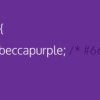
This looks like an excellent talk from Zach Leatherman. It’s packed with useful recommendations. I hope the video’s posted soon!

This looks like an excellent talk from Zach Leatherman. It’s packed with useful recommendations. I hope the video’s posted soon!

An excellent overview of some significant upgrades to NPR.org along with some advice to web developers.
No one was more deserving of this award than Molly. No one.
Thank you for all you have done for the Web Mols! And, especially, thank you for all you have done for me.
Accessibility is an afterthought in much of our industry. In order to change that, education needs to change and code schools need to change. Karl nails it in this post:
While Hacker You should be applauded for their regular lunch-and-learns, I think that all computer schools should include accessibility embedded in core curriculum. It will create an alumni population better prepared to create interfaces that are universally usable. Their alumni will be differentiated by their ability to consider the user’s needs. After all, if you’re not developing for the user, who are you developing for?

Time to stop blurring sensitive client information in your slide decks and articles. Cover it in a black box instead.
Did you know the ARIA role attribute allows for multiple values? It’s how role supports fault tolerance: the first value (of the space separated list) is applied, but if the assistive technology in use doesn’t understand it, the second value will be tried, etc. until a usable alternative is found. It works a lot like font stacks.

Jens Oliver Meiert on why we should continue to tidy up to and improve on our creations rather than letting them site once we’ve launched them. I’ve never been once for maintenance contracts with clients, but I also believe that sites that aren’t tended to every now and again can become overgrown or, worse, wither and die.
This is an update on where things stand with the ECMAScript 6/2015 spec in WebKit. Currently in Safari for El Capitan & iOS9:
for…of loops, andComing soon:
let, const, and class block scopingFor an excellent overview of ES6 support, consult this handy chart.

Are you building web projects for the developing world? If so, you can probably forego any in-depth testing on flagship phones like the iPhone 6S.

Did you ever wonder how we ended up with color names like “thistle” and “peru” in the CSS color spec? This article provides a little history.